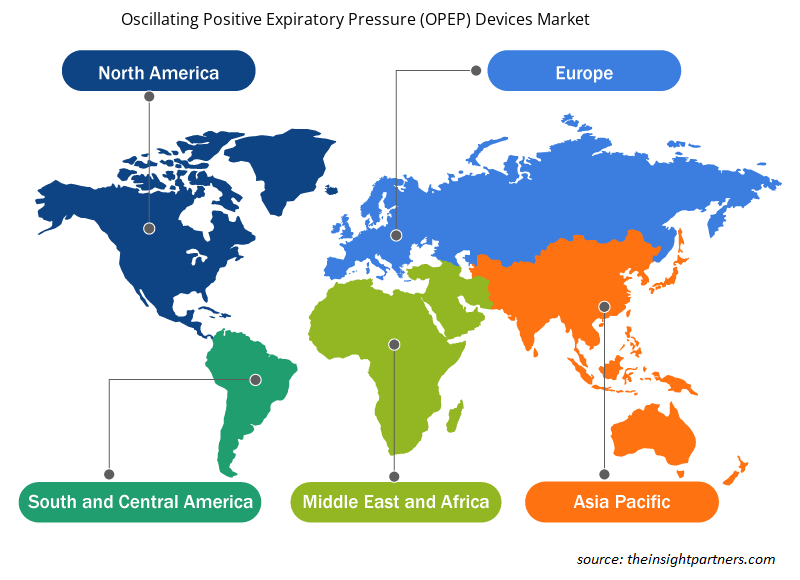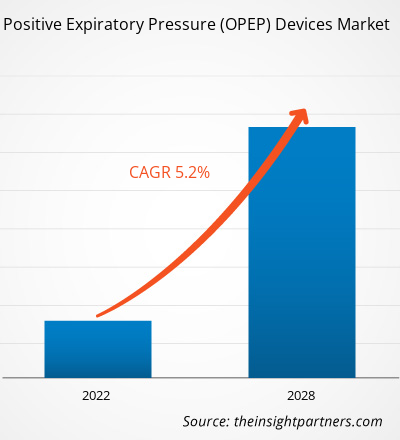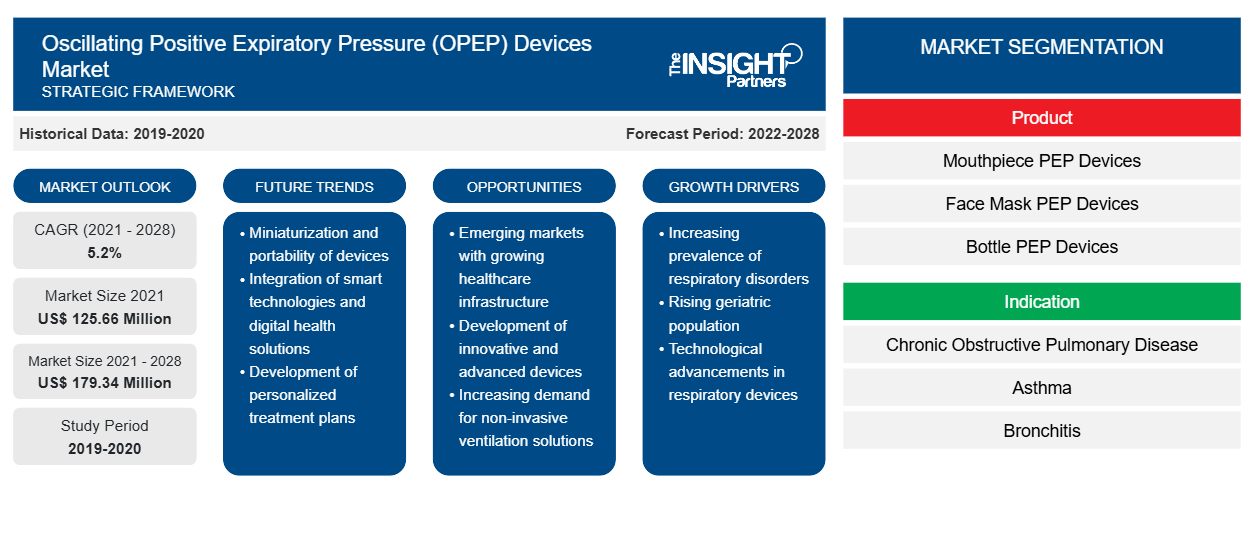Se proyecta que el mercado de dispositivos de presión espiratoria positiva oscilante (OPEP) crecerá de US$ 125,66 millones en 2021 a US$ 179,34 millones en 2028; se estima que crecerá a una CAGR del 5,2% durante 2021-2028.
Los dispositivos de presión espiratoria positiva oscilatoria (PEO) se han utilizado como complemento de la fisioterapia torácica tradicional (PTC) para ayudar a eliminar las secreciones respiratorias en personas que no pueden toser, especialmente aquellas con enfermedades crónicas. El uso de dispositivos de PEO todavía es limitado en trastornos crónicos de las vías respiratorias, como fibrosis quística, bronquiectasias, bronquitis, asma bronquial y síndrome de discinesia ciliar primaria. En la enfermedad pulmonar obstructiva crónica (EPOC), los dispositivos de presión espiratoria positiva oscilatoria (PEO) ayudan a eliminar el esputo.
El crecimiento del mercado de dispositivos de presión espiratoria positiva oscilante (OPEP) se atribuye a la creciente prevalencia de la enfermedad pulmonar obstructiva crónica (EPOC) y el asma, y a los avances en las tecnologías médicas. Sin embargo, la escasa concienciación y el acceso limitado a los dispositivos OPEP obstaculizan el crecimiento del mercado.
Personalice este informe según sus necesidades
Obtendrá personalización en cualquier informe, sin cargo, incluidas partes de este informe o análisis a nivel de país, paquete de datos de Excel, así como también grandes ofertas y descuentos para empresas emergentes y universidades.
-
Obtenga las principales tendencias clave del mercado de este informe.Esta muestra GRATUITA incluirá análisis de datos, desde tendencias del mercado hasta estimaciones y pronósticos.
Perspectivas de mercado
La creciente prevalencia de la enfermedad pulmonar obstructiva crónica (EPOC) y el asma impulsa el crecimiento del mercado
La incidencia de EPOC y fibrosis quística está aumentando en todo el mundo. Según la Organización Mundial de la Salud (OMS), las exacerbaciones de EPOC son eventos críticos. La discapacidad y la mortalidad relacionadas con la EPOC impulsan la demanda de dispositivos OPEP. Según el Centro para el Control y la Prevención de Enfermedades (CDC), aproximadamente 9 millones de adultos fueron diagnosticados con bronquitis crónica en 2018. Además, el asma se está volviendo común entre personas de todas las edades, géneros y razas. Según los CDC, aproximadamente 300 millones de personas en todo el mundo padecen asma, y se espera que se agreguen 100 millones para 2025. La prevalencia, la gravedad y la mortalidad del asma varían drásticamente en los EE. UU. El asma afecta a más de 25 millones de personas en los EE. UU., lo que equivale al 7,7 % de los adultos y al 8,4 % de los niños. Según el Informe mundial sobre asma de 2018 sobre Auckland, Nueva Zelanda, el asma ocupa el puesto 16 entre las principales causas de discapacidad y el 28 entre las mayores fuentes de carga de enfermedad, según la evaluación de los años de vida ajustados por discapacidad. Es común en países de altos ingresos, mientras que la mayoría de las muertes relacionadas con el asma se producen en países de ingresos bajos y medios. Por lo tanto, la creciente prevalencia de EPOC y asma impulsa la demanda de dispositivos de limpieza de mucosidades, como los dispositivos OPEP, lo que refuerza el crecimiento del mercado de dispositivos de presión espiratoria positiva oscilante (OPEP).
Perspectivas basadas en productos
El mercado de dispositivos de presión espiratoria positiva oscilante (OPEP), según el producto, está segmentado en dispositivos PEP con boquilla, dispositivos PEP con mascarilla y dispositivos PEP con botella. El segmento de dispositivos PEP con boquilla tuvo la mayor participación del mercado en 2021. Además, se prevé que registre una CAGR del 5,3% en el mercado durante el período de pronóstico. El PEP con boquilla ayuda a eliminar la mucosidad de los pulmones. También puede prevenir el colapso pulmonar o abrir áreas que se han colapsado. Uno de los factores clave que impulsan el mercado de dispositivos PEP con boquilla es la creciente población de ancianos, junto con tasas más altas de enfermedades crónicas como la enfermedad pulmonar obstructiva crónica (EPOC) y el asma. Según los Centros para el Control y la Prevención de Enfermedades (CDC), aproximadamente 9 millones de personas serán diagnosticadas con bronquitis crónica para 2020, lo que impulsa la necesidad de dispositivos con boquilla.
Información sobre indicaciones
Según las indicaciones, el mercado de dispositivos de presión espiratoria positiva oscilante (OPEP) está segmentado en enfermedad pulmonar obstructiva crónica (EPOC), asma, bronquitis, bronquiectasias, fibrosis quística y otros. El segmento de EPOC tuvo la mayor participación del mercado en 2021. Sin embargo, se prevé que el segmento de asma registre una CAGR del 6,0% durante el período de pronóstico. La EPOC es una enfermedad común y tratable que se caracteriza por la limitación progresiva del flujo de aire y la destrucción de los tejidos. Se asocia con cambios estructurales en los pulmones debido a la inflamación crónica por la exposición prolongada a partículas o gases nocivos, más comúnmente el humo del cigarrillo. La inflamación crónica provoca el estrechamiento de las vías respiratorias y la disminución del retroceso pulmonar.
Los lanzamientos y aprobaciones de productos son estrategias que las empresas suelen adoptar para expandir su presencia global y sus carteras de productos. Además, los actores del mercado de dispositivos de presión espiratoria positiva oscilante (OPEP) se centran en la estrategia de asociación para ampliar su clientela, lo que, a su vez, les permite mantener su marca a nivel mundial. Se prevé que el mercado prospere en los próximos años debido al desarrollo de productos innovadores por parte de los actores del mercado.
Dispositivos de presión espiratoria positiva oscilante
Perspectivas regionales del mercado de dispositivos de presión espiratoria positiva oscilante (OPEP)
Los analistas de Insight Partners explicaron en detalle las tendencias y los factores regionales que influyen en el mercado de dispositivos de presión espiratoria positiva oscilante (OPEP) durante el período de pronóstico. Esta sección también analiza los segmentos y la geografía del mercado de dispositivos de presión espiratoria positiva oscilante (OPEP) en América del Norte, Europa, Asia Pacífico, Medio Oriente y África, y América del Sur y Central.

- Obtenga datos específicos regionales para el mercado de dispositivos de presión espiratoria positiva oscilante (OPEP)
Alcance del informe de mercado sobre dispositivos de presión espiratoria positiva oscilante (OPEP)
| Atributo del informe | Detalles |
|---|---|
| Tamaño del mercado en 2021 | US$ 125,66 millones |
| Tamaño del mercado en 2028 | US$ 179,34 millones |
| CAGR global (2021-2028) | 5,2% |
| Datos históricos | 2019-2020 |
| Período de pronóstico | 2022-2028 |
| Segmentos cubiertos |
Por producto
|
| Regiones y países cubiertos |
América del norte
|
| Líderes del mercado y perfiles de empresas clave |
|
Densidad de actores del mercado de dispositivos de presión espiratoria positiva oscilante (OPEP): comprensión de su impacto en la dinámica empresarial
El mercado de dispositivos de presión espiratoria positiva oscilante (OPEP) está creciendo rápidamente, impulsado por la creciente demanda de los usuarios finales debido a factores como la evolución de las preferencias de los consumidores, los avances tecnológicos y una mayor conciencia de los beneficios del producto. A medida que aumenta la demanda, las empresas amplían sus ofertas, innovan para satisfacer las necesidades de los consumidores y aprovechan las tendencias emergentes, lo que impulsa aún más el crecimiento del mercado.
La densidad de actores del mercado se refiere a la distribución de las empresas o firmas que operan dentro de un mercado o industria en particular. Indica cuántos competidores (actores del mercado) están presentes en un espacio de mercado determinado en relación con su tamaño o valor total de mercado.
Las principales empresas que operan en el mercado de dispositivos de presión espiratoria positiva oscilante (OPEP) son:
- Compañía farmacéutica Allergan.
- PARI GmbH
- Smiths Medical
- Fisioterapia aérea
- D
Descargo de responsabilidad : Las empresas enumeradas anteriormente no están clasificadas en ningún orden particular.

- Obtenga una descripción general de los principales actores clave del mercado de dispositivos de presión espiratoria positiva oscilante (OPEP)
Perfiles de empresas
- Compañía farmacéutica Allergan.
- PARI GmbH
- Medicina de Smith
- Fisioterapia aérea
- ATENCIÓN MÉDICA D•R BURTON
- Medica Holdings, LLC
- CEGLA Medizintechnik GmbH & Co. KG
- Atención sanitaria competente
- Trudell Medical Internacional
- Mercurio médico
- Análisis histórico (2 años), año base, pronóstico (7 años) con CAGR
- Análisis PEST y FODA
- Tamaño del mercado, valor/volumen: global, regional y nacional
- Industria y panorama competitivo
- Conjunto de datos de Excel
Informes recientes
Testimonios
Razón para comprar
- Toma de decisiones informada
- Comprensión de la dinámica del mercado
- Análisis competitivo
- Información sobre clientes
- Pronósticos del mercado
- Mitigación de riesgos
- Planificación estratégica
- Justificación de la inversión
- Identificación de mercados emergentes
- Mejora de las estrategias de marketing
- Impulso de la eficiencia operativa
- Alineación con las tendencias regulatorias























 Obtenga una muestra gratuita para - Mercado de dispositivos de presión espiratoria positiva oscilante (OPEP)
Obtenga una muestra gratuita para - Mercado de dispositivos de presión espiratoria positiva oscilante (OPEP)